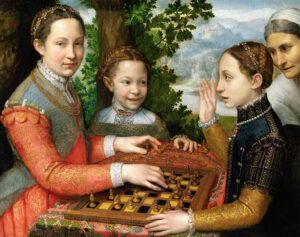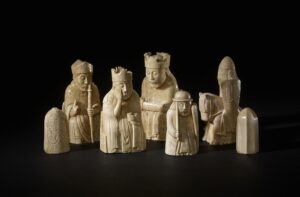
The Chess Game, Sofonisba Anguissola (1555 – National Museum Poznań)
The Queen’s Gambit on Netflix has recently been credited with helping to fuel a chess renaissance. The series about an orphan with a preternatural mastery of chess features a beautiful wardrobe for its main protagonist, 1960s music, and high-stakes international tournaments. With the onset of winter and a second round of lockdown looming over many countries, people are turning to games – such as chess – for a respite. Sales of chess sets and accessories have skyrocketed as much as 215%, with interest mainly in wooden and vintage sets. Millions are subscribing to and playing matches on websites, breaking existing records.
However, chess’ popularity predates the current craze. For centuries, military strategists, royalty, children and others have enjoyed this board game, which is one of the oldest in the world. Chess is believed to have originated in northwest India before spreading along the Silk Road, eventually reaching Western Europe via Persia and Islamic Iberia. The oldest archaeological chess artifacts, made of ivory, were excavated in Uzbekistan and date to approximately 760 A.D. Chess has been depicted in numerous artworks, literature, and films, including a memorable match in the Harry Potter franchise and a painting by Sofonisba Anguissola (pictured above).

Lewis Chessman (Photo: British Museum)
Antique chess pieces are not only historically important, but also offer a fascinating glimpse into artistic, commercial, and cultural trends. The Lewis Chessmen, discovered in 1831, are possibly the finest known example of medieval European ivory chess pieces. They are believed to be the first chess pieces to depict bishops and they possess distinctly human forms. The set was discovered on the island of Lewis in Scotland, as part of a hoard containing 93 artifacts in total. The pieces date back to the 12th or 13th century, with 82 pieces forming part of the British Museum’s collection and 11 pieces held by National Museums Scotland. The chess pieces were likely made in Trondheim, Norway from walrus ivory and teeth. They exhibit many interesting details, such as bulging eyes and a rook (depicted as a standing soldier or “warder”) biting its shield like a Viking berserker. The pieces reflect the ties between Scandinavia and Scotland at the time the carvings were made. Interestingly, the Lewis Chessmen were among the first medieval antiquities acquired by the British Museum, and they have also been featured as #61 in the 2010 BBC Radio series A History of the World in 100 Objects.
As with all artwork and artifacts, provenance is extremely important. In fact, if may even be more important for chess pieces, which are portable in nature and thus prone to separation and forgery. It is rare for entire sets to survive intact; some pieces in circulation are even high-profile copies of masterpieces, such as the Metropolitan Museum of Art’s reproductions. The Met’s collection even includes copies of certain Lewis Chessmen. The Lewis pieces’ provenance prior to its discovery in 1831 is unknown, although they may have been the property of a merchant or a local leader, buried for safeguarding or for future trade with Iceland. In fact, there are conflicting accounts of their discovery. Supposedly, Malcolm MacLeod discovered the trove in a dune, exhibited the chess set for a brief period, and then sold the pieces to Captain Roderick Ryrie. Ryrie then exhibited the pieces at a meeting of the Society of Antiquaries of Scotland in April 1831, and the set was split up shortly after. Ultimately, the British Museum purchased the majority of the pieces for £84 on the recommendation of chess enthusiast Sir Frederic Madden. This proved to be a solid investment, as one of the chess set’s related pieces (a previously unrecognized warder) was sold in July 2019 at Sotheby’s for £735,000. It had been bought by an antiques dealer in Edinburgh for £5 fifty-five years before, and the dealer’s family had no idea of the object’s importance until the family submitted it for appraisal. The warder was described as “characterful” and as having “real presence” by Sotheby’s expert Alexander Kader.

Man Ray Chess Set
While the Lewis Chessmen are exceptional, they are not the only chess sets to have achieved fame. The Charlemagne Chess Set, currently held by the National Library of France in Paris, was made in Salerno, Italy in the late 11th century. It formed part of the treasury of the Basilica of Saint Denis and has unusual dimensions. The set is seen as symbolic, depicting the various roles of individuals in medieval society. Yet despite its name, it never belonged to Charlemagne. And unfortunately, only 16 pieces are left from the 30 inventoried in the 16th century. The Àger chess pieces are another unique example of the game, as they were crafted from rock crystal. Believed to have been made in Egypt, Iraq or eastern Iraq during the 9th century, they were deposited in the Àger monastery in present-day Catalonia, Spain during the 11th century. As the chess set has an Islamic origin, the pieces are not humans but rather present an abstract style with arabesque decorations. Finally, Surrealist artist Man Ray produced a modern design for a chess set inspired by everyday objects. These were then reduced to simple, semi-abstract forms: the knight was represented by a violin scroll, the bishop by a flask, and the king by an Egyptian pyramid. Reproductions of Man Ray’s are available to players at all price points.
We hope you have enjoyed this journey through the fascinating world of chess. Amineddoleh & Associates is proud to represent collectors in pursuing their creative passions, whether that is through the sale of artwork or by acquiring antique board games that display craftsmanship and historical value. Collectors should always remember to perform due diligence and consult experienced legal professionals when considering art and cultural property-related transactions.